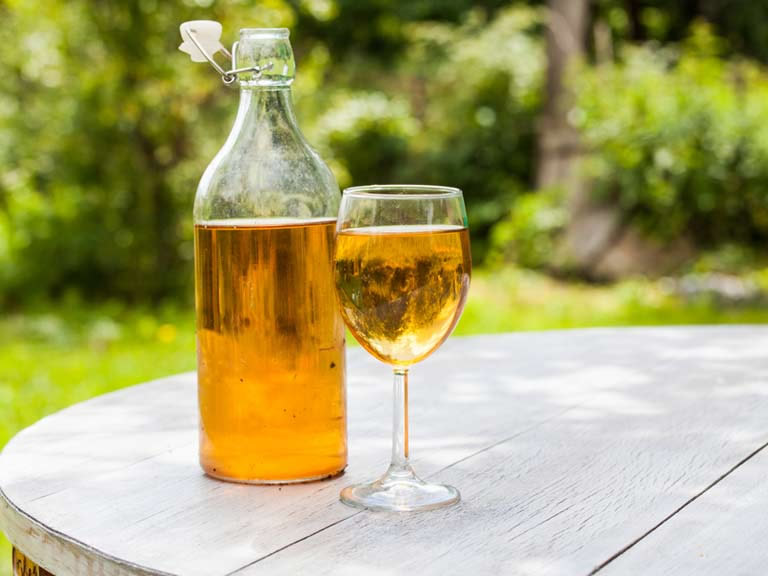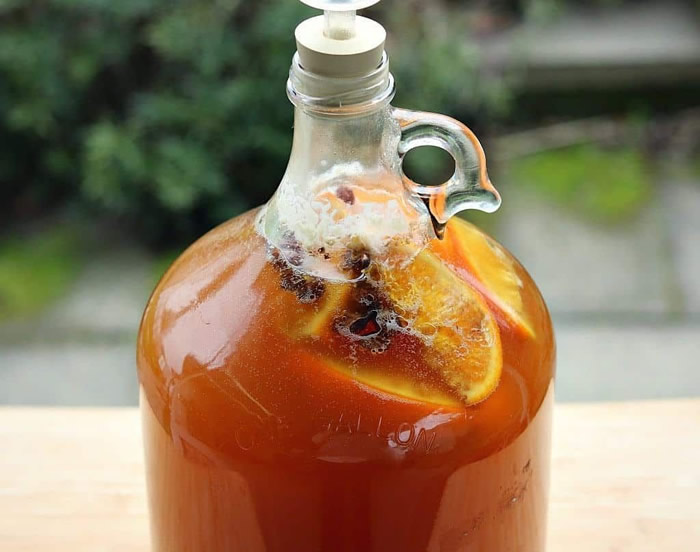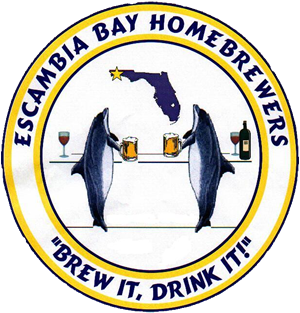In this issue
- Welcome New Members
- Making Mead at Home
- Mead Recipes
- SOM Winners 2022
- Upcoming Styles of the Month for 2022
- May Schedule of Events
- Seville Gumbo Ya-Ya Cook-Off
-
 President - Bernie Hill
President - Bernie Hill
-
 Vice Pres. - Rob Young
Vice Pres. - Rob Young
-
 Treasurer - Jim Martin
Treasurer - Jim Martin
-
 Secretary - Karen Young
Secretary - Karen Young
-
 Chairman of the Board - Ron Gray
Chairman of the Board - Ron Gray
Welcome New Members
Linda and Chris Howe. Linda and Chris have been married 19 years and have lived in Pace about 3 years now. They have two adult sons and enjoy riding Chris’ Harley or brewing beer in their spare time. Chris has been brewing about 12 years and they are so thrilled to find our wonderful club. WELCOME LINDA AND CHRIS!

Spring Brew Highlight - Mead

Making Mead at Home
Mead, also known as “honey wine”, conjures images of husky, horned-helmeted warriors and ferocious Goths drinking from clay chalices and is believed to be the world’s oldest alcoholic libation. Associated with civilizations of the past, this fermented drink may seem dated, but it has grown steadily in the United States on the commercial and homebrewing side.
What is Mead?
Mead is as simple as fermenting diluted honey. It’s generally higher in alcohol than beer and puts the beverage more in line with grape wine, but it can be flavored like beer with fruits, spices, grains, hops, and more. Mead is produced in a variety of sweetness levels from dry to sweet, and carbonation levels vary from still to sparkling.
And within the tapestry of mead, there are subdivisions. For example, if mead is mixed with beer or brewed with hops and malt, it becomes a braggot. If mead is made with fruit, it is called melomel, while hydromel is a watered-down version consumed in Spain and France.
Mead is produced in wineries (called meaderies), and bottles are usually sold in wine shops. However, when hops are added to mead, it is often grouped into craft beer. In reality, though, mead is it’s own category, just like cider, sake, wine, and beer.
This tutorial covers one of the easiest ways to make mead at home, without the use of any heat in order to preserve the flavor and aroma characteristics of the honey. For more information on how to make outstanding mead, check out 5 Tips for Making better Mead.
How to Make Mead
Like brewing beer, making mead can be as simple or as complicated as you want to make it. This tutorial covers one of the easiest ways to make mead at home, without the use of any heat in order to preserve the flavor and aroma characteristics of the honey. For the healthy fermentation, it is recommended to incorporate a staggered nutrient schedule.
Review
Read through the mead recipe and review the following meadmaking steps entirely before starting your day to ensure maximum efficiency and understanding.
This tutorial will walk you through the process for making a traditional dry mead. The same steps can be applied to most mead recipes, although instructions for other mead styles will vary.
Gather Supplies
Ensure you have all the equipment and ingredients necessary to make mead.
Clean Equipment
Using unscented cleanser, thoroughly clean all meadmaking equipment.
Debris on equipment can harbor microorganisms that can spoil a batch of mead, even with proper sanitation.
Warm Honey
Submerge the containers of honey in a warm water bath. A sink or bucket works well, but make sure no water will get into the containers.
Warming the honey ahead of time will help liquefy any solid crystals in the honey and make it easier to pour into the fermenter.
Sanitize equipment
While the honey is warming, thoroughly sanitize all equipment and tools that will come into contact with the ingredients.
We recommend no-rinse sanitizer in a spray bottle for quick sanitation!
Add Water
Fill the clean and sanitized primary fermenter half way with water. 2-3 gallons
Add Honey
Remove the honey from the warm water bath, and proceed to add it to the half-full fermenter.
Using a sanitized spoon, or by simply sealing the fermenter and shaking, mix the honey into the water until dissolved.
Top off
Add enough water to the honey and water mixture in the fermenter until you reach a total volume of 5 gallons (19 L).
Mix thoroughly
With the full batch volume in the fermenter, use a sanitized spoon or seal the carboy and shake until the honey and water is completely mixed. If after mixing you notice a darker layer on the bottom half of the carboy and lighter layer on top, then the honey is not fully dissolved.
Take temperature
Using a clean and sanitzed thermometer, measure the temperature of the must. Allow the must to cool to 65-75°F (18-24°C) prior to adding the yeast.
Gravity Reading
Optional: Before pitching the yeast, pull a sample of the must and take a gravity reading using a hydrometer. This will allow you to measure the original gravity and calculate the alcohol content after fermentation
Do not return the sample to the fermenter because it can cause infection.
If you’ve never measured gravity before, take a look at how to read a hydrometer.
Pitch Yeast
Once in the 60-70°F (15.5-21°C) temperature range, it is time to add the yeast to the must. This process is called “pitching the yeast.”
Though optional, when using dry yeast it is highly recommended to follow the manufacture's directions on how to rehydrate dry yeast prior to adding it to the must.
After pitching the yeast, you can add in the nutrient, too.
Seal Fermenter
If using a bucket fermenter for primary, tightly secure the lid and put an airlock in the hole of the lid. If using a carboy jug, use the appropriate sized bung with an airlock.
Fill the airlock with no-rinse santizer, a high-gravity alcohol, or something else that will not infect or change the flavor of the mead if it gets inside.
Aerate must
As is the case when making beer, it is crucial to provide enough oxygen to the yeast at the point of pitching. While mixing the honey into the water will provide a lot of oxygen, but you may want to also give the primary fermenter a few shakes just in case.
After the initial aeration of the must at the time of pitching, it is crucial that you prevent the must/mead from splashing because this can cause oxidation, which can instill off flavors and shorten shelf life.
Store fermenter
With the yeast pitched and the primary sealed, place the fermenter in a location where the temperature will be within the range of 60-70°F, with lower temperatures being more favorable.
Monitor Fermentation
Signs of fermentation should be visible within 24 hours. You should notice the airlock bubbling. This is CO2, a byproduct of fermentation, escaping through the airlock. If the bubbling slows down or stops, it doesn’t necessarily mean fermentation has ceased.
Transfer to secondary
After 2-3 weeks, the bubbling of the airlock should slow down or cease completely, signifying primary fermentation is nearly complete. At this point, the mead can be transferred off the yeast into a secondary where it can age for a longer period of time.
Transfer the mead to a clean and sanitized secondary fermenter using clean and sanitized equipment, such as an auto-siphon.
Note: you want as little head space as possible in secondary to prevent the presence of oxygen.
Age
Place the secondary fermenter back in an area that can hold the yeast’s target fermentation temperatures with minimal disturbance.
During secondary, fermentation will finish up and the mead will start to clear. It is up to the meadmaker how long they want to bulk-age before bottling. A few weeks to a few months is a good place to start.
Bottle or keg
After the mead has dropped clear and fermentation is complete, it’s time to package! The only surefire way to ensure fermentation is complete is with your hydrometer. If gravity readings are consistent over the course of 1-2 weeks, it is safe to assume the yeast have called it quits.
Mead can be packaged in bottles or kegs just like beer, so we will leave it up to you. This recipe is for a “still” mead so there is no bottle priming or forced carbonation necessary.
Enjoy!
All that’s left is to enjoy your homemade mead!
Since this is a non-carbonated example, you theoretically don’t need to wait any period time after it’s bottled, or if kegging you only need to set kegs to serving pressure. That being said, some meadmakers will set the bottles aside for even more aging. We say do both!
Mead Recipes

Crimson Stag
Recipe courtesy of Adam Crockett, Upper Reach Meadery.Adam Crockett’s love for undertaking difficult processes lies in the belief that the more time and effort you invest, the better the end result. For background on this award-winning pyment mead, read “Mead Matters” by Andrew luberto in the Sep/Oct issue of Zymurgy or check out the American Mead Makers Association’s webinar series entitled "Mead Matters."
Ingredients:
-
HONEY AND FRUIT
- 15 lb. (6.80 kg) wildflower honey
- 11 lb. (4.99 kg) Carménère grapes
- 7 lb. (3.18 kg) black raspberries
- 5 lb. (2.27 kg) aronia berries
-
YEAST
- 15 g Lalvin Bourgovin RC212 yeast
-
ADDITIONAL ITEMS
- 19 g Go-Ferm
- 3 g Rouge Berry
- 9 g Fermaid O @ yeast pitch
- 9 g Fermaid O @ 1/3 sugar break (1.085)
- 4 g Fermaid K @ active fermentation (24–30 hours)
Specifications:
Directions:
Rehydrate yeast with Go-Ferm dissolved in a small amount of water. Crush grapes and add to honey, along with whole black raspberries and aronia berries. Top up with water to reach 5 gal. (18.9 L)
Pitch yeast. Ideal fermentation temperature is 70–72°F (21–22°C) but it’s not a problem to ferment warmer. Add Fermaid O and Fermaid K according to indicated schedule. Cold crash when gravity reaches 1.033 (8.3°Bx) and press off fruit. Add sulfites and sorbate to stabilize.
Filter out yeast through step filtration until stable. Let bulk age for 3–6 months and enjoy!

Orange Clove Mead
Orange Clove Mead (This is one of the best recipes, tastes great and is easy to make. If you are looking for a first recipe to try I recommend this one.Interesting flavor and makes 1 gallon
- 1 gallon of Spring Water
- Yeast: Fleishcmanns (1 packet)
- 25 Raisins
- 1 Cinnamon stick
- 1 whole orange, sliced and peels included
- 1 pinch of allspice
- 1 pinch of nutmeg
- 3 1/2 pounds of clover honey
- 1 whole clove
Simply mix all the ingredients then pitch your yeast. Caring for this mead? The beautiful thing about this mead is that you can rack it off of all the oranges and raisins any time you want to, or you can just leave it all in there. When the oranges sink to the bottom you are ready to drink it or bottle it.. Simple as that. I recommend you bottle it and let it age for a couple more months. This recipe is just simply delicious.
Style of the Month Spring Winners!
January - American Brown Ale

Jim Martin
February - Belgium Wit

Jim Martin
March - Irish Red

Paul Wallis
UPCOMING STYLES OF THE MONTH FOR 2022
- April - American Wheat
- May - Ordinary Bitter
- June - Rye IPA

Calendar of Events
- 🥂Sunday, May 1st - Craftathon Beer Fest 2022 11:00 am to 4:00 pm Detail
- 🥂Saturday, May 7th - Gary's Big Brew Day 2:00 pm to 5:00 pm Detail
- 🥂Saturday, May 14th - Wino's Meeting at Jim and Nanci's 4:00 pm to 7:00 pm Detail
- 🥂Saturday, may 21st - Spring Brew-B-Q/ Crawfish Boil at Gulf Coast Brewery 4:00 pm to 7:00 pm. Cooks will be Mike Helf & Chris Tingle Detail
View our Calendar for locations.
2022 Gumbo Ya-Ya Cook-Off
CONGRATULATIONS TO Ryan Fried, Edna Fried and Karen Young for winning 2nd place in the Peoples' Choice award at the Seville Quarter Annual Gumbo YaYa Cook-off April 9th to benefit Big Brothers Big Sisters of Northwest Florida!





Cheers!
Send Us Newsletter Content

Do you have a story, recipe, something to share with the club? We are looking for member contributions on all things homebrew—beer, wine, cider, mead, and OAB. Send your article and photos to the club secretary.
Have photos to share with the club? Send them in to info@ebhb.org! They may be included in the website, newsletter, Instagram page, and the Escambia Bay Homebrewers Facebook page! Don’t forget to send a short description or story to accompany the photos.
